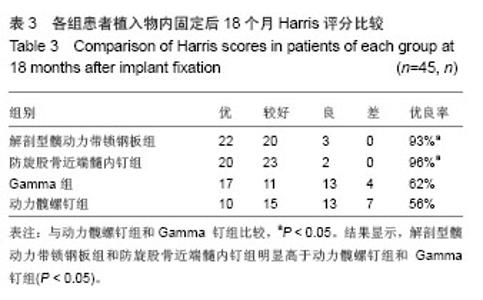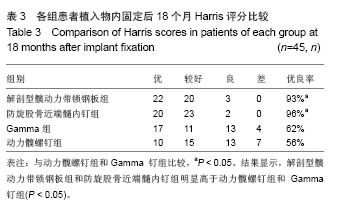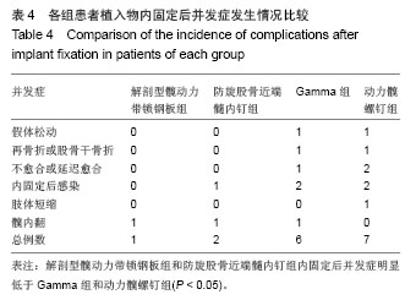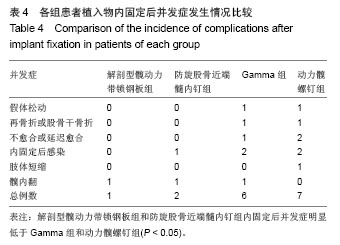| [1]Majernicek M, Dungl P, Kolman J, et al. Osteosynthesis of intracapsular femoral neck fractures by dynamic hip screw (DHS) fixation. Acta Chir Orthop Traumatol Cech. 2009;4: 319-325.
[2]Ho M, Garau G, Walley G, et al. Minimally invasive dynamic hip screw for fixation of hip fractures. Int Orthop. 2009;2: 555-560.
[3]Terry Canale S. Campell's Operative Orthopedics.10th ed. Jinan: Shangdong Science &Technology Press, 2005:2760.
[4]陈军明,李文成,蔡宇.选择适宣的金属植入物固定治疗投骨近端骨折[J].中国组织工程研究,2013,17(9):1679-1685.
[5]Harris WH. Traumatic arthritis of the hip after dislocation and acetabular fractures: treatment by mold arthroplasty. An end-result study using a new method of result evaluation. J Bone Joint Surg Am. 1969;4:737-755.
[6]张经纬,蒋垚,张先龙,等. 股骨转子间骨折不同手术方法比较[J]. 中华骨科杂志,2005,25(1):7-11.
[7]周国强.解剖型钢板与动力髋螺钉治疗老年股骨粗隆间骨折的对比分析[J].临床和实验医学杂志,2011,16 (10):1279-1280.
[8]赵勇刚.解剖型钢板与DHS治疗老年股骨粗隆间骨折的效果比较[J].中国医学创新,2011,23(8):37-38.
[9]Kitamura S, Hasegawa Y, Suzuki S, et al. Functional outcome after hip fracture in Japan. Clip Orthop. 1998;(348):29-36.
[10]韩亮.三种固定方法治疗股骨粗隆间骨折98例分析比较[J].中国保健营养, 2012, 23(11):395-396.
[11]薛春堂,郝鸿伟,刘敬,等.老年人股骨粗隆间骨折109例手术疗效分析[J].陕西医学杂志,2010,39(7):844-845.
[12]张进.DHS和Gamma钉治疗股骨粗隆间骨折的疗效比较[J].中国医药指南,2011,9(1):37-38.
[13]陈红卫,王子阳,赵品益,等. 动力髋螺钉治疗股骨粗隆间骨折并发症原因分析及防治[J].实用骨科杂志,2005,11(5):404-405.
[14]方大标,王秋根,张秋林,等.医源性因素对DHS治疗髋部骨折疗效的影响[J]. 中华创伤骨科杂志,2004,6(5):525-528.
[15]郭世明,丁真奇,洪加源,等.3种内固定方法治疗老年股骨粗隆间骨折的病例对照研究[J].中国骨伤,2012,25(6):474-477.
[16]夏广春.老年股骨粗隆问骨折两种内固定方式疗效分析[J].中国当代医药,2011,18(15):152-155.
[17]高斌.老年股骨粗隆间骨折不同内固定治疗疗效观察[J].四川医学,2012, 33(1):80-82.
[18]杜一鑫,陈国富.解剖型钢板与动力髋螺钉治疗老年股骨粗隆间骨折的疗效对比[J].中国现代医生,2011,49(7):84-85.
[19]Lung YT, Kam WL, Leung YF, et al. Subcapital femoral neck fracture following successful trochanteric fracture treatment with a dynamic hip screw: a report of five cases. Orthop Surg (Hong Kong). 2007;15:238-241.
[20]Bhatti A, Abbasi A. Intra pelvic total migration of sliding screw in intertrochanteric fracture. Coll Physicians Surg Pak. 2007; 17(6): 371-373.
[21]Anwar R, Boorgula V, Nicholl JE. Intrapelvic penetration of the dynamic hip screw during removal: lesson learnt--always use a coupling screw. Trauma. 2007;5:105-106.
[22]刘海春,陈允震,杨子来,等.股骨粗隆间粉碎性骨折不同内固定疗效分析[J].中国骨与关节损伤杂志,2005,20(1):18-20.
[23]梁国建.股骨转子间骨折的不同手术治疗效果分析[J].中国卫生产业,2013, 9(2):157-159.
[24]刘爱国,谷文光,邓亮,等.不同手术方法治疗老年股骨转子间骨折疗效分析[J].中国矫形外科杂志,2012,20(12):1072-1076.
[25]Adams CI, Robinson CM, Court-Brown CM, et al. Prospective randomized controlled trial of an intramedullary nail versus dynamic screw and plate for intertrochanteric fractures of the femur. Orthop Trauma. 2001;6:394-400.
[26]熊鹰,王大兴,柳百烁,等.解剖型髋动力带锁钢板的研制及临床应用[J].中国矫形外科杂志,2008,16(6):419-422.
[27]黄异飞,潘静,熊鹰.解剖型髋动力带锁钢板治疗股骨转子间骨折的疗效评价[J].中华创伤杂志,2009,25(1):61-65.
[28]赵仲伟,施新革,李学民,等.锁定钢板与动力髋螺钉治疗股骨转子间骨折的Meta分析[J].军医进修学院学报,2012,33(8):853-857. |









